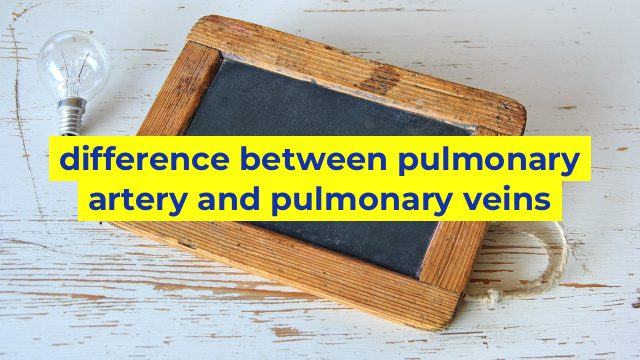The Difference Between Pulmonary Artery and Pulmonary Veins: Understanding the Anatomy
The human body is a complex system of organs, tissues, and cells that work together to maintain vital physiological functions. One of the most important structures in this system is the cardiovascular system, which includes the heart, blood vessels, and blood. The lungs, which play a critical role in oxygen exchange and carbon dioxide removal, are also an important part of this system. In this article, we will explore the difference between two key structures in the lungs: pulmonary artery and pulmonary veins.
Pulmonary Artery
The pulmonary artery is one of the major blood vessels in the human body. Its primary role is to transport deoxygenated blood from the right ventricle of the heart to the lungs, where it is oxygenated. The pulmonary artery branches off into smaller blood vessels, which become progressively smaller until they reach the alveoli in the lungs, where gas exchange takes place.
The walls of the pulmonary artery are relatively thin compared to other arteries in the body, as the pressure in this vessel is lower than in other parts of the cardiovascular system. This allows for easier gas exchange in the lungs, as the thin walls of the alveoli allow for efficient diffusion of oxygen and carbon dioxide.
Pulmonary Veins
While the pulmonary artery carries deoxygenated blood from the heart to the lungs, the pulmonary veins transport oxygenated blood from the lungs back to the heart. The lungs are responsible for oxygenating the blood and removing carbon dioxide, which then enters the bloodstream via the pulmonary veins.
There are four pulmonary veins in the human body, two on each side. These veins are located in close proximity to the pulmonary arteries, and they connect to the left atrium of the heart. The left atrium is responsible for receiving oxygenated blood from the lungs, which is then pumped into the left ventricle of the heart, where it is distributed to the rest of the body.
Conclusion
In summary, the pulmonary artery and the pulmonary veins are two key structures in the lungs that play different roles in the cardiovascular system. The pulmonary artery carries deoxygenated blood from the heart to the lungs, while the pulmonary veins transport oxygenated blood from the lungs back to the heart. Understanding the anatomy and function of these structures is essential for overall cardiovascular health and can help prevent or manage diseases that affect these structures. If you are concerned about your cardiovascular health, it is important to consult your healthcare provider for guidance and treatment.
Table difference between pulmonary artery and pulmonary veins
| Characteristic | Pulmonary Artery | Pulmonary Veins |
|---|---|---|
| Function | Carries deoxygenated blood from the heart to the lungs | Carries oxygenated blood from the lungs to the heart |
| Vessel Type | Artery | Vein |
| Pressure | High pressure | Low pressure |
| Blood Oxygenation | Deoxygenated | Oxygenated |


